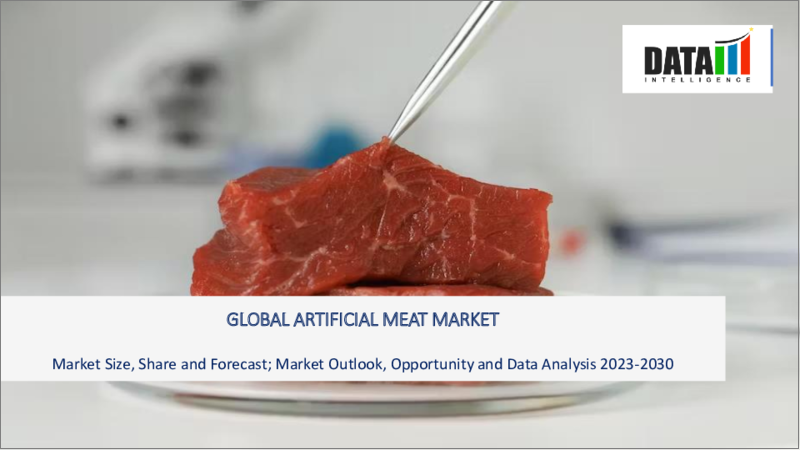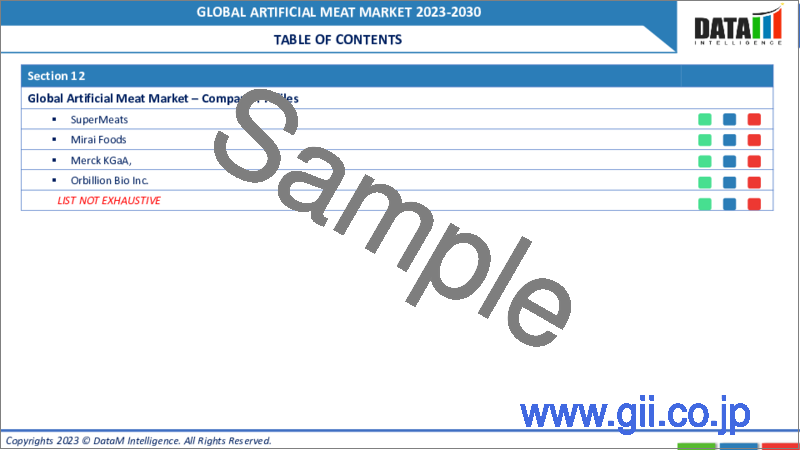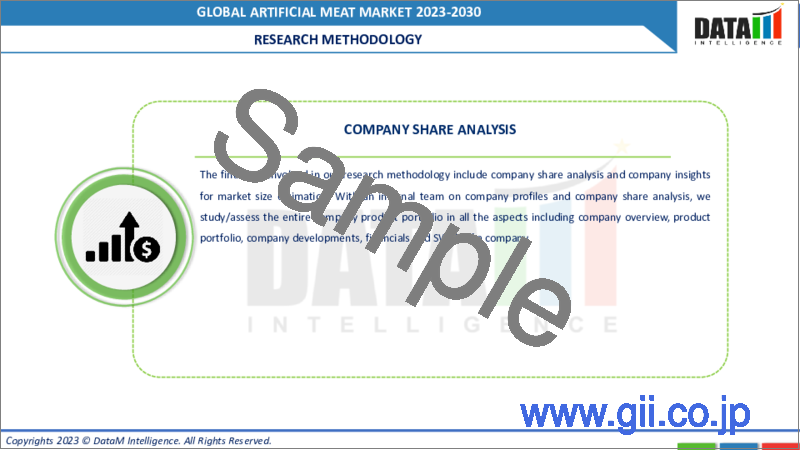|
|
市場調査レポート
商品コード
1304455
人工肉の世界市場-2023年~2030年Global Artificial Meat Market - 2023-2030 |
||||||
カスタマイズ可能
適宜更新あり
|
|||||||
| 人工肉の世界市場-2023年~2030年 |
|
出版日: 2023年07月07日
発行: DataM Intelligence
ページ情報: 英文 200 Pages
納期: 即日から翌営業日
|
- 全表示
- 概要
- 目次
市場概要
世界の人工肉市場は、2022年に1億5,040万米ドルに達し、2023~2030年の予測期間中にCAGR 14.2%で成長し、2030年には4億3,500万米ドルに達すると予測されています。
人工肉は、筋肉細胞などの動物細胞を少量採取し、これらの細胞を制御された条件下で培養液中で増殖させることにより、従来生産されている食肉と実質的に同一の食肉を生産します。人工肉の製造過程では通常、牛や鶏などの動物から筋肉細胞を分離し、細胞の増殖と分裂に必要な栄養素を含む栄養豊富な培養液に入れます。時間の経過とともに、これらの細胞は増殖して筋肉組織を形成し始め、それを採取して肉製品に加工することができます。
足場ベースの食肉生産は、従来の肉製品の構造を模倣し、細胞の成長をサポートする足場や枠組みを使用する肉の代替法です。バイオリアクターは人工肉の生産において重要な役割を果たし、細胞培養が増殖・複製するための制御された環境を提供することで、持続可能な研究室育ちの肉の生産につながっています。人工肉の生産には組織工学技術が活用され、従来の畜産を必要とせずに、細胞を培養し、機能的な肉製品に組み立てることができます。クリーンミートは、動物細胞の培養によって生産される人工肉の一形態であり、従来の食肉生産に代わる持続可能で動物実験のない代替手段を提供します。
市場力学
動物福祉に対する消費者の関心の高まりが人工肉産業を牽引
多くの消費者は、食用の動物を飼育・屠殺する従来の食肉生産システムにおける動物の福祉を懸念しています。人工肉の生産プロセスでは、動物を飼育・屠殺することなく、動物細胞のサンプルを少量採取し、それを使って研究室で肉を成長させます。このプロセスは、食肉生産に関わる動物の苦痛の量を減らし、動物福祉を懸念する人々にとって魅力的な選択肢となります。
動物の苦痛を軽減するだけでなく、人工肉市場は動物の生活環境を改善する可能性も提供しています。人工肉は食用に動物を飼育する必要がないため、農家は牛乳や羊毛の生産など、他の目的に使用される動物の生活環境の改善に注力することができます。人工肉市場はまた、食肉産業における動物の扱いをより人道的にする可能性も提供しています。従来型の食肉の需要を減らすことで、市場は農家や生産者に対し、より良い生活環境や、抗生物質やホルモン剤の使用削減など、より人道的な慣行を採用するよう促すことができます。
革新的な新食品の開発が人工肉市場の成長機会を顕著に示す
新しい食品の開発は、人工肉市場にとって大きなチャンスです。消費者が従来の食肉生産が環境と倫理に与える影響をより強く認識するようになるにつれて、植物由来の食肉製品や研究室育ちの食肉製品など、代替食品を求める傾向が強まっています。消費者は、食物の選択が環境や動物福祉に与える影響をより意識するようになっており、持続可能で倫理的な食物の選択肢に対する需要が高まっています。
従来の食肉生産に伴う環境問題や動物福祉の問題を回避して生産できる人工肉は、この需要を満たすのに好都合です。主要プレーヤーによる製品発売の増加は、予測期間中のセグメント成長を後押しします。例えば、2022年7月20日、培養肉企業のMeatableは、研究室育ちの人工ソーセージを市場に投入しました。
人工肉の高コストが市場成長を妨げる
培養肉のコストが高いことは、市場成長を妨げる大きな要因です。培養肉の生産プロセスには複雑かつ資源集約的な技術が必要であり、これが現在、従来生産された肉と比較して高コストの一因となっています。人工肉の開発には、研究開発活動への多額の投資が必要です。科学者や研究者は、細胞培養技術を最適化し、適切な増殖培地を開発し、生産プロセスの拡張性を高めるために、広範な研究や実験を行う必要があります。
人工肉は、研究室で培養された動物の細胞を用いて作られます。このプロセスには、細胞の成長を促すための増殖培地が必要です。このステップには多くの投資が必要で、人工肉の生産量が制限され、一般消費者にとっては高価すぎる製品となってしまいます。培養中の動物細胞から作られた最初のハンバーガーには28万米ドル以上が費やされました。増殖培地1リットルが400ドルもします。1キログラムの培養牛肉には最大600リットルの増殖培地が必要になるため、コストはすぐにかさみます。
COVID-19の影響
パンデミックは、人工肉セクターを含む様々な産業において、製造やサプライチェーンの混乱を引き起こしています。移動の制限、労働力不足、物流の課題は、人工肉製品の生産と流通に影響を及ぼしています。パンデミック中の景気後退と不確実性は、消費者の購買力に影響を与えました。人工肉製品は従来の食肉より価格が高いことが多く、値ごろ感や高級品への消費意欲という点で課題に直面する可能性があります。
パンデミックは、人工肉セクターの市場参入や投資活動に遅れをもたらしました。市場への参入や事業拡大を目指す新興企業や企業は、資金面での制約、投資家の関心の低さ、事業活動の難しさなどの問題に直面する可能性があります。
目次
第1章 調査手法と調査範囲
第2章 定義と概要
第3章 エグゼクティブサマリー
第4章 市場力学
- 影響要因
- 促進要因
- 動物福祉に対する消費者の関心の高まりが人工肉産業を牽引
- 革新的な新食品の開発が人工肉市場の成長機会を顕著に示す
- 抑制要因
- 人工肉の高コストが市場成長を妨げる
- 機会
- 影響分析
- 促進要因
第5章 産業分析
- ポーターのファイブフォース分析
- サプライチェーン分析
- 価格分析
- 規制分析
第6章 COVID-19分析
第7章 由来別
- 鴨肉
- 牛肉
- 家禽
- 魚介類
- 豚肉
第8章 用途別
- ハンバーガー
- ミートボール
- ナゲット
- ホットドッグ
- ソーセージ
第9章 流通チャネル別
- スーパーマーケット/ハイパーマーケット
- 専門店
- オンライン販売
- その他
第10章 地域別
- 北米
- 米国
- カナダ
- メキシコ
- 欧州
- ドイツ
- 英国
- フランス
- イタリア
- スペイン
- その他欧州
- 南米
- ブラジル
- アルゼンチン
- その他南米
- アジア太平洋
- 中国
- インド
- 日本
- オーストラリア
- その他アジア太平洋地域
- 中東・アフリカ
第11章 競合情勢
- 競合シナリオ
- 市況/シェア分析
- M&A分析
第12章 企業プロファイル
- Meatable
- 会社概要
- 製品ポートフォリオと説明
- 財務概要
- 主な発展
- Just Inc.
- Aleph Farms
- Mosa Meat
- Finless Foods
- Memphis Meats
- SuperMeats
- Mirai Foods
- BlueNalu
- Orbillion Bio Inc.
第13章 付録
Market Overview
The Global Artificial Meat Market reached US$ 150.4 million in 2022 and is expected to reach US$ 435 million by 2030 growing with a CAGR of 14.2% during the forecast period 2023-2030.
Artificial meat is created by taking a small sample of animal cells, such as muscle cells, and then growing these cells in a culture medium under controlled conditions to produce meat that is virtually identical to conventionally produced meat. The process of creating artificial meat typically involves isolating muscle cells from an animal, such as a cow or chicken, and then placing them in a nutrient-rich culture medium that contains the necessary nutrients for the cells to grow and divide. Over time, these cells multiply and begin to form muscle tissue, which can be harvested and processed into meat products.
Scaffold-based meat production is a meat alternative method that involves using scaffolds or frameworks to support the growth of cells, mimicking the structure of traditional meat products. Bioreactors play a crucial role in the production of artificial meat, providing a controlled environment for cell cultures to grow and replicate, leading to the production of sustainable and lab-grown meat. Tissue engineering techniques are utilized in the production of artificial meat, allowing for the cultivation and assembly of cells into functional meat products without the need for traditional animal farming. Clean meat is a form of artificial meat produced by culturing animal cells, offering a sustainable and cruelty-free alternative to traditional meat production.
Market Dynamics
The Rising Concern of Consumers Towards Animal Welfare is Driving the Artificial Meat Industry
Many consumers are concerned about the welfare of animals in traditional meat production systems, which involve raising and slaughtering animals for food. The process of producing artificial meat involves taking a small sample of animal cells and using them to grow meat in a lab, without the need to raise and slaughter animals. This process reduces the amount of animal suffering involved in meat production, making it an attractive option for those who are concerned about animal welfare.
In addition to reducing animal suffering, the artificial meat market also offers the potential to improve the living conditions of animals. Because artificial meat does not require animals to be raised for food, farmers can focus on improving the living conditions of animals used for other purposes, such as milk or wool production. The artificial meat market also offers the potential for more humane treatment of animals in the meat industry. By reducing the demand for conventionally produced meat, the market could encourage farmers and producers to adopt more humane practices, such as better living conditions and reduced use of antibiotics and hormones.
Developing Innovative New Food Products Shows a Remarkable Opportunity for Artificial Meat Market Growth
The development of new food products is a significant opportunity for the artificial meat market. As consumers become more aware of the environmental and ethical implications of traditional meat production, they are increasingly seeking out alternatives, including plant-based and lab-grown meat products. Consumers are becoming more conscious of the impact of their food choices on the environment and animal welfare, there is a growing demand for sustainable and ethical food options.
Artificial meat, which can be produced without the environmental and animal welfare issues associated with traditional meat production, is well-positioned to meet this demand. An increase in product launches by major key players helps to boost segment growth over the forecast period. For instance, on July 20, 2022, Meatable, a cultivated meat company, launched lab-grown synthetic sausages in the market.
High Cost of the Artificial Meat Hampers Market Growth
The high cost of cultured meat is indeed a significant restraint that hampers market growth. The production process of cultured meat involves complex and resource-intensive techniques, which currently contribute to its high cost compared to conventionally produced meat. The development of artificial meat requires substantial investment in research and development activities. Scientists and researchers need to conduct extensive studies and experiments to optimize cell culture techniques, develop suitable growth media, and enhance the scalability of the production process.
Artificial meat is made by using cells from animals that are grown in in a laboratory. This process required a growth medium to stimulate cell growth. This step required lot of investment that limit the amount of artificial meat production and making the product too expensive for average consumers. More than $280,000 was spent on the first burger created from animal cells in culture. A liter of growth media may cost $400. Costs can soon mount because one kilogram of cultured beef may require up to 600 liters of growth media.
COVID-19 Impact
The pandemic has caused disruptions in manufacturing and supply chains across various industries, including the artificial meat sector. Restrictions on movement, labor shortages, and logistical challenges have affected the production and distribution of artificial meat products. Economic downturns and uncertainties during the pandemic have impacted consumer purchasing power. Artificial meat products, often priced higher than conventional meat, may face challenges in terms of affordability and consumer willingness to spend on premium products.
The pandemic has caused delays in market entry and investment activities in the artificial meat sector. Start-ups and companies looking to enter the market or expand their operations may face challenges due to financial constraints, limited investor interest, or difficulties in conducting business activities.
Segment Analysis
The Poultry Segment is Expected to Hold the Largest Market Share Due to the increase in the Government Approvals
The global artificial meat market by source has been segmented by duck, beef, poultry, seafood, and pork.
Poultry refers to meat produced through cellular agriculture techniques in a laboratory setting. It involves the cultivation of animal cells, typically obtained from a biopsy of live animals, which are then cultured and multiplied to create meat products. Poultry has gained attention as a potential solution to address the environmental and ethical concerns associated with conventional poultry production.
Poultry has the potential to significantly reduce the environmental impact of traditional poultry farming. Poultry eliminates the need for raising and slaughtering animals for meat production. An increase in government approvals for artificial poultry meat helps to boost segment growth over the forecast period. For instance, on March 22, 2023, GOOD Meat, a California-based cultivated meat company received approval from the U.S. Food and Drug Administration for lab-grown chicken.
Geographical Analysis
Increase in the Government Initiatives and Approvals of Artificial Meat Helps to Boost Regional Growth
North America has a strong tradition of environmentalism and sustainability, and people are becoming increasingly aware of the negative impact that traditional meat production can have on the environment. Artificial meat, which has a lower carbon footprint and uses fewer resources, may be seen as a more sustainable alternative. There is growing concern about the health risks associated with consuming large amounts of meat, particularly processed meat.
On November 18, 2022, the US Food And Drug Administration (FDA) approved the consumption and sales of lab-grown meat. Also, on March 21 2023, GOOD Meat, a meat company received no questions certifications from the U.S. Food and Drug Administration. More than two years after its historic certification and introduction in Singapore, this completes a necessary step in introducing GOOD Meat to restaurants and retail in the United States. The increase in government approvals for artificial meat helps to boost regional growth over the forecast period.
Competitive Landscape
The major global players include: Meatable, Just Inc., Aleph Farms, Mosa Meat, Finless Foods, Memphis Meats, SuperMeat, Mirai Foods, BlueNalu, and Orbillion Bio Inc.
Why Purchase the Report?
- To visualize the global artificial meat market segmentation based on source, application, and distribution channel and understand key commercial assets and players.
- Identify commercial opportunities by analyzing trends and co-development.
- Excel data sheet with numerous data points of artificial meat market-level with all segments.
- PDF report consists of a comprehensive analysis after exhaustive qualitative interviews and an in-depth study.
- Product mapping available as Excel consisting of key products of all the major players.
The global artificial meat market report would provide approximately 61 tables, 63 figures, and 200 Pages.
Target Audience 2023
- Manufacturers/ Buyers
- Industry Investors/Investment Bankers
- Research Professionals
- Emerging Companies
Table of Contents
1. Methodology and Scope
- 1.1. Research Methodology
- 1.2. Research Objective and Scope of the Report
2. Definition and Overview
3. Executive Summary
- 3.1. Snippet by Source
- 3.2. Snippet by Application
- 3.3. Snippet by Distribution Channel
- 3.4. Snippet by Region
4. Dynamics
- 4.1. Impacting Factors
- 4.1.1. Drivers
- 4.1.1.1. The Rising Concern of Consumers Towards Animal Welfare is Driving the Artificial Meat Industry
- 4.1.1.2. Developing Innovative New Food Products Shows a Remarkable Opportunity for Artificial Meat Market Growth
- 4.1.2. Restraints
- 4.1.2.1. High Cost of the Artificial Meat Hampers Market Growth
- 4.1.3. Opportunity
- 4.1.4. Impact Analysis
- 4.1.1. Drivers
5. Industry Analysis
- 5.1. Porter's Five Force Analysis
- 5.2. Supply Chain Analysis
- 5.3. Pricing Analysis
- 5.4. Regulatory Analysis
6. COVID-19 Analysis
- 6.1. Analysis of COVID-19
- 6.1.1. Scenario Before COVID-19
- 6.1.2. Scenario During COVID-19
- 6.1.3. Scenario Post COVID-19
- 6.2. Pricing Dynamics Amid COVID-19
- 6.3. Demand-Supply Spectrum
- 6.4. Government Initiatives Related to the Market During Pandemic
- 6.5. Manufacturers Strategic Initiatives
- 6.6. Conclusion
7. By Source
- 7.1. Introduction
- 7.1.1. Market Size Analysis and Y-o-Y Growth Analysis (%), By Source
- 7.1.2. Market Attractiveness Index, By Source
- 7.2. Duck*
- 7.2.1. Introduction
- 7.2.2. Market Size Analysis and Y-o-Y Growth Analysis (%)
- 7.3. Beef
- 7.4. Poultry
- 7.5. Seafood
- 7.6. Pork
8. By Application
- 8.1. Introduction
- 8.1.1. Market Size Analysis and Y-o-Y Growth Analysis (%), By Application
- 8.1.2. Market Attractiveness Index, By Application
- 8.2. Burgers*
- 8.2.1. Introduction
- 8.2.2. Market Size Analysis and Y-o-Y Growth Analysis (%)
- 8.3. Meatballs
- 8.4. Nuggets
- 8.5. Hot Dogs
- 8.6. Sausages
9. By Distribution Channel
- 9.1. Introduction
- 9.1.1. Market Size Analysis and Y-o-Y Growth Analysis (%), By Distribution Channel
- 9.1.2. Market Attractiveness Index, By Distribution Channel
- 9.2. Supermarkets/Hypermarkets*
- 9.2.1. Introduction
- 9.2.2. Market Size Analysis and Y-o-Y Growth Analysis (%)
- 9.3. Specialty Stores
- 9.4. Online Sales
- 9.5. Others
10. By Region
- 10.1. Introduction
- 10.1.1. Market Size Analysis and Y-o-Y Growth Analysis (%), By Region
- 10.1.2. Market Attractiveness Index, By Region
- 10.2. North America
- 10.2.1. Introduction
- 10.2.2. Key Region-Specific Dynamics
- 10.2.3. Market Size Analysis and Y-o-Y Growth Analysis (%), By Source
- 10.2.4. Market Size Analysis and Y-o-Y Growth Analysis (%), By Application
- 10.2.5. Market Size Analysis and Y-o-Y Growth Analysis (%), By Distribution Channel
- 10.2.6. Market Size Analysis and Y-o-Y Growth Analysis (%), By Country
- 10.2.6.1. The U.S.
- 10.2.6.2. Canada
- 10.2.6.3. Mexico
- 10.3. Europe
- 10.3.1. Introduction
- 10.3.2. Key Region-Specific Dynamics
- 10.3.3. Market Size Analysis and Y-o-Y Growth Analysis (%), By Source
- 10.3.4. Market Size Analysis and Y-o-Y Growth Analysis (%), By Application
- 10.3.5. Market Size Analysis and Y-o-Y Growth Analysis (%), By Distribution Channel
- 10.3.6. Market Size Analysis and Y-o-Y Growth Analysis (%), By Country
- 10.3.6.1. Germany
- 10.3.6.2. The U.K.
- 10.3.6.3. France
- 10.3.6.4. Italy
- 10.3.6.5. Spain
- 10.3.6.6. Rest of Europe
- 10.4. South America
- 10.4.1. Introduction
- 10.4.2. Key Region-Specific Dynamics
- 10.4.3. Market Size Analysis and Y-o-Y Growth Analysis (%), By Source
- 10.4.4. Market Size Analysis and Y-o-Y Growth Analysis (%), By Application
- 10.4.5. Market Size Analysis and Y-o-Y Growth Analysis (%), By Distribution Channel
- 10.4.6. Market Size Analysis and Y-o-Y Growth Analysis (%), By Country
- 10.4.6.1. Brazil
- 10.4.6.2. Argentina
- 10.4.6.3. Rest of South America
- 10.5. Asia-Pacific
- 10.5.1. Introduction
- 10.5.2. Key Region-Specific Dynamics
- 10.5.3. Market Size Analysis and Y-o-Y Growth Analysis (%), By Source
- 10.5.4. Market Size Analysis and Y-o-Y Growth Analysis (%), By Application
- 10.5.5. Market Size Analysis and Y-o-Y Growth Analysis (%), By Distribution Channel
- 10.5.6. Market Size Analysis and Y-o-Y Growth Analysis (%), By Country
- 10.5.6.1. China
- 10.5.6.2. India
- 10.5.6.3. Japan
- 10.5.6.4. Australia
- 10.5.6.5. Rest of Asia-Pacific
- 10.6. Middle East and Africa
- 10.6.1. Introduction
- 10.6.2. Key Region-Specific Dynamics
- 10.6.3. Market Size Analysis and Y-o-Y Growth Analysis (%), By Source
- 10.6.4. Market Size Analysis and Y-o-Y Growth Analysis (%), By Application
- 10.6.5. Market Size Analysis and Y-o-Y Growth Analysis (%), By Distribution Channel
11. Competitive Landscape
- 11.1. Competitive Scenario
- 11.2. Market Positioning/Share Analysis
- 11.3. Mergers and Acquisitions Analysis
12. Company Profiles
- 12.1. Meatable*
- 12.1.1. Company Overview
- 12.1.2. Product Portfolio and Description
- 12.1.3. Financial Overview
- 12.1.4. Key Developments
- 12.2. Just Inc.
- 12.3. Aleph Farms
- 12.4. Mosa Meat
- 12.5. Finless Foods
- 12.6. Memphis Meats
- 12.7. SuperMeats
- 12.8. Mirai Foods
- 12.9. BlueNalu
- 12.10. Orbillion Bio Inc.
LIST NOT EXHAUSTIVE
13. Appendix
- 13.1. About Us and Services
- 13.2. Contact Us





